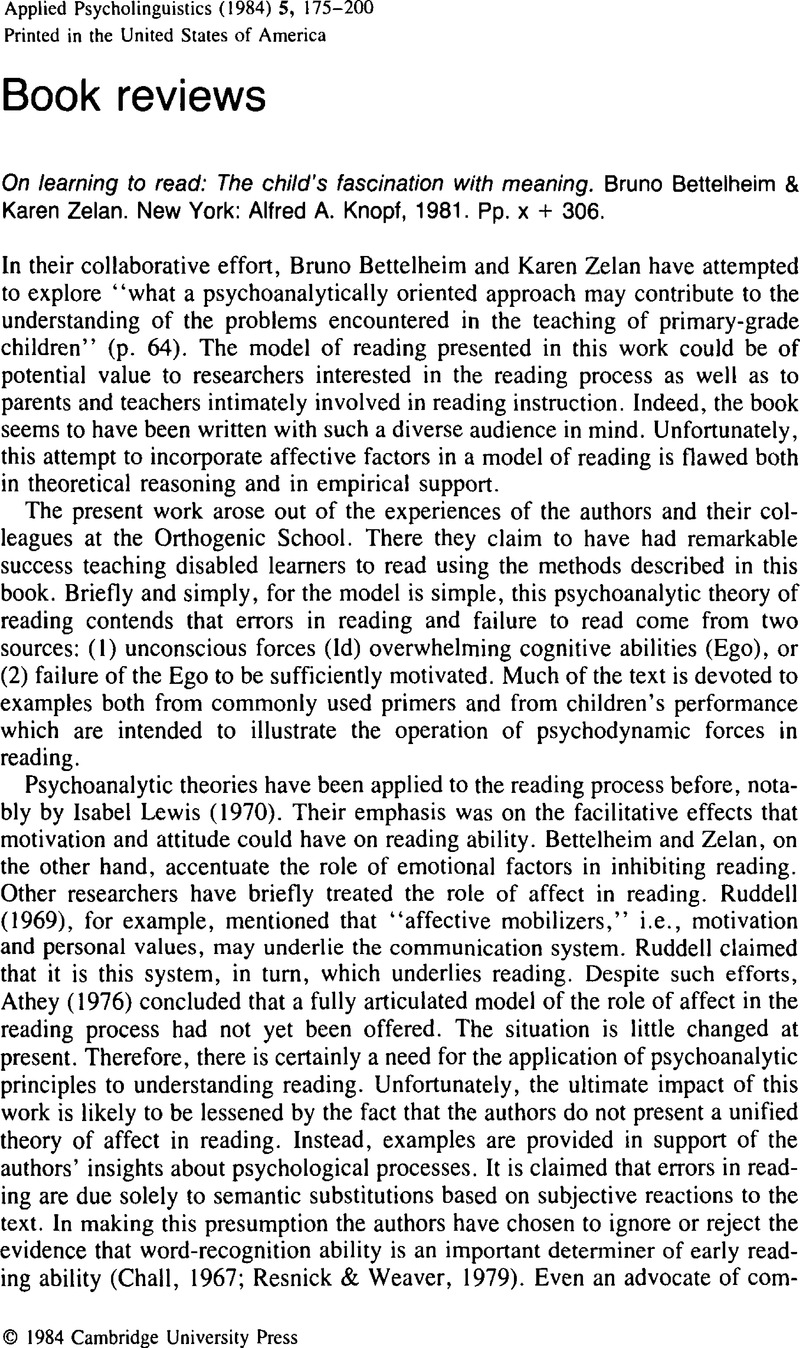No CrossRef data available.
Article contents
On learning to read: The child's fascination with meaning. Bruno Bettelheim & Karen Zelan. New York: Alfred A. Knopf, 1981. Pp. x + 306.
Published online by Cambridge University Press: 28 November 2008
Abstract
An abstract is not available for this content so a preview has been provided. Please use the Get access link above for information on how to access this content.

- Type
- Book Reviews
- Information
- Copyright
- Copyright © Cambridge University Press 1984
References
REFERENCES
Athey, I. (1976). Reading research in the affective domain. In Singer, H. & Ruddell, R. (Eds.), Theoretical models and processes of reading. Newark, DL: International Reading Association.Google Scholar
Beck, I. (1981). Reading problems and instructional practices. In Mackinnon, G. & Waller, T. (Eds.), Reading research: Advances in theory and practice. New York: Academic Press.Google Scholar
Brown, A. (1980). Metacognitive development and reading. In Spiro, R., Bruce, B., & Brewer, W. (Eds.), Theoretical issues in reading comprehension. Hillsdale, NJ: Erlbaum.Google Scholar
Chall, J. (1979). The great debate: Ten years later, with a modest proposal for reading stages. In Resnick, L. & Weaver, P. (Eds.), Theory and practice of early reading. Hillsdale, NJ: Erlbaum.Google Scholar
Clymer, T., & Venezky, R. (1982). The Ginn Reading Program. Lexington, MA: Ginn and Company.Google Scholar
Ehri, L. (1978). Beginning reading from a psycholinguistic perspective: Amalgamation of word identities. In Ehri, L., Barron, R., & Feldman, J. (Eds.), The recognition of words. Newark, DL: International Reading Association.Google Scholar
Goodman, K. (1969). Analysis of oral reading miscues: Applied psycholinguistics. Reading Research Quarterly, 5, 9–30.CrossRefGoogle Scholar
Goodman, K., & Goodman, Y. (1979). Learning to read is natural. In Resnick, L. & Weaver, P. (Eds.), Theory and practice of early reading. Hillsdale, NJ: Erlbaum.Google Scholar
Lewis, I. (1970). Psychoanalytic points of view. In Russell, D. H., The dynamics of reading (R. Ruddell [Ed.]), Waltham, MA: Ginn and Company.Google Scholar
Mattingly, I. (1972). Reading, the linguistic process, and linguistic awareness. In Kavanagh, J. & Mattingly, I. (Eds.), Language by ear and by eye. Cambridge, MA: M.I.T. Press.Google Scholar
Menyuk, P. (1971). The acquisition and development of language. Englewood Cliffs, NJ: Prentice-Hall.Google Scholar
Menyuk, P. (1980). Syntactic competence and reading. Paper presented at C.U.N.Y. Graduate Center, May 1980.Google Scholar
Resnick, L., & Weaver, P. (Eds.), (1979). Theory and practice of early reading. Hillsdale. NJ: Erlbaum.Google Scholar
Ruddell, R. (1969). Psycholinguistic implications for a systems of communication model. In Goodman, K. & Fleming, J. (Eds.), Psycholinguistics and the teaching of reading. Newark, DL: International Reading Association.Google Scholar
Sigel, I., & Cocking, R. (1977). Cognitive development from childhood to adolescence: A constructivist perspective. New York: Holt, Rinehart & Winston.Google Scholar


